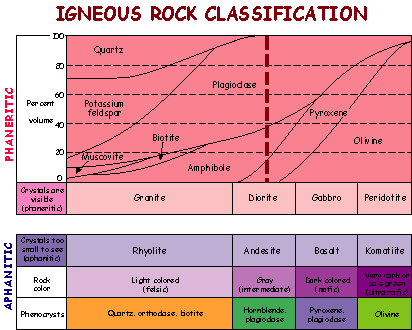
LAB 3
Igneous Rocks
Shiprock, New Mexico (remnant volcanic neck)
|
|
LAB 3 Igneous Rocks |
|
Shiprock, New Mexico (remnant volcanic neck) |
Objectives:
In this lab we will draw on our experience and knowledge of minerals to learn about the common types of igneous rocks. We will identify minerals in rocks, and we will classify different igneous rocks based on their texture and composition. We will also use the major igneous rock types as proxies for different types of crust in the Earth in order to reinforce our ideas about the nature of plates and plate-tectonic processes. Finally, we will explore igneous rock texture as it relates to crystallization history and processes of volcanic eruption.Reading:
Skinner, Porter & Botkin, The Blue Planet Chap. 7: p.149-151.Useful web site:
Ocean Drilling Program
http://www-odp.tamu.edu/
Background:
Igneous rocks are formed by the cooling and solidification of silicate liquid (magma). Magmas that erupt and flow as lavas at Earth's surface are said to form extrusive rocks, whereas magmas that crystallize (i.e., freeze) within the earth form intrusive rocks. Extrusive rocks are most often associated with volcanoes, so are commonly referred to as volcanic. Intrusive rocks often crystallize in large bubble-shaped bodies called plutons, and are commonly referred to as plutonic.We classify igneous rocks based on two physical characteristics, their texture and composition. Texture is the overall appearance of the rock given by the size, shape and arrangement of mineral grains, usually as crystals. The texture of an igneous rock is controlled by the crystallization process; hence, texture is a good guide to the history of a rock-forming magma. In many igneous rocks, the arrangement of crystals is random and the rock has a uniform composition, giving the rock a massive texture. Other igneous rocks may be layered compositionally due to internal flow of magma or eruption of lava. Some rocks contain crystals of notably different size, and some are partly or completely glassy (i.e., they are non-crystalline). If a rock is wholly comprised of crystals, we call this phaneritic. If no crystals are visible to the naked eye in all or most of the rock, we call it aphanitic.
Rock composition is reflected by the proportions of minerals of different chemical composition. A rock that contains an abundance of minerals rich in silicon and aluminum (e.g., quartz, feldspar) is said to be felsic. Conversely, a rock containing abundant minerals rich in calcium, iron and magnesium (e.g., amphibole, pyroxene, olivine) is said to be mafic. Rocks in between these end-members of the igneous rock spectrum are said to be of intermediate composition. From a rock's composition, we get a good idea of its origin, or where its parent magma came from. Even without knowing the exact chemical composition of a rock, we can estimate its composition fairly accurately by knowing the kinds and proportions of minerals it contains. We use the proportions of minerals in conjunction with texture to classify the rock and assign a name, as shown on the diagram below:

To classify a rock, first decide whether it has visible crystals or not. If so, use the part for phaneritic rocks; if not, then use the part for aphanitic rocks. Next, the hard part … try to estimate the relative proportions of the minerals. You will need to be able to recognize different minerals from Lab 2, so don’t forget them yet! For example, a rock that contains about 60% plagioclase feldspar, 25% amphibole, and 15% pyroxene (see dashed red line), would be called a diorite.
If it’s an aphanitic rock, with either no crystals at all, or some crystals in a fine porcelain-like matrix, the try to come up with a name based on how dark the rock is, what crystals it contains, or both.
Note that a granite is equivalent to a rhyolite in terms of its chemical composition, only the granite contains crystalline minerals. Under the right circumstances, the rhyolite could have developed the exact same minerals.